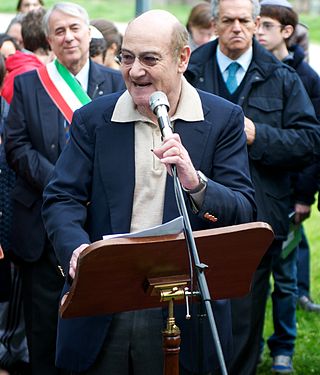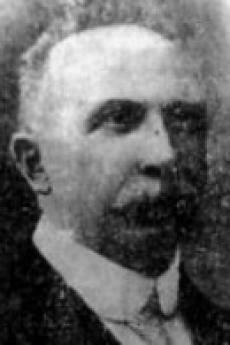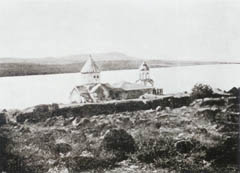
San Lazzaro degli Armeni is a small island in the Venetian Lagoon which has been home to the monastery of the Mekhitarists, an Armenian Catholic congregation, since 1717. It is one of the two primary centers of the congregation, along with the monastery in Vienna.

Mkhitar Sebastatsi, anglicized: Mekhitar of Sebaste, Italian: Mechitar was an Armenian Catholic monk, scholar and theologian who founded the Mekhitarist Order, which has been based on San Lazzaro island near Venice since 1717.

Armin Theophil Wegner was a German soldier and medic in World War I, a prolific author, and a human rights activist. Stationed in the Ottoman Empire during World War I, Wegner was a witness to the Armenian genocide and the photographs he took documenting the plight of the Armenians today "comprises the core of witness images of the Genocide."

Tserents (Armenian: Ծերենց, born Hovsep Shishmanian, was a prominent Armenian writer.

Stefano Cagol is an Italian contemporary artist living in Italy, Germany and Norway. He works with video, photography and installation and performance art in the fields of conceptual art, environmental art / eco art and land art, and has reflected for years on borders, viruses, flags and climate issues.

Giovanni Pietro Ligario (1686–1748) was an Italian painter and architect of the late-Baroque.

Armenians in Italy covers the Armenians who live in Italy. There are currently 2,500-3,500 Armenians in Italy mainly residing in Milan, Rome and Venice; another main centre of Armenian culture and history is Padua.

Gabriele Nissim is an Italian journalist, historian and essayist whose works discuss Eastern Europe.

Giacomo Gorrini was an Italian diplomat and historian.
Pierantonio Costa was an Italian businessman, and diplomat who was the Italian honorary consul in Kigali during the Rwandan genocide in 1994. He was noted for the humanitarian assistance and safe passages that he arranged for over 2,000 people including over 375 children fleeing violence during this time. He was a recipient of the Commander of the Order of Merit of the Italian Republic honor. He was nominated for the 2011 Nobel Peace Prize along with two Rwandan women Zura Karuhimbi and Yolande Mukagasana.

Urbatagirk or "The Book of Friday" was the first printed book in the Armenian language. It was printed in Venice (Italy) in 1512 by Hakob Meghapart. Its content was partly religious, partly secular, consisting of cures and prayers for the sick, ancient writings, myths, long quotations from Grigor Narekatsi's Book of Lamentations, the Prayer of Cyprianos of Antioch, the story of the Virgin and Justinian, etc.

Bazmavēp is an academic journal covering Armenian studies. It is published by the Mechitarist monastery in San Lazzaro degli Armeni, Venice, Italy. According to Robert H. Hewsen, it is the first Armenian scholarly journal. and the longest-running Armenian publication still being published.

Adır Island or Lim Island, is the largest island in Lake Van, located in the northeastern side of the lake. During the Armenian genocide upwards of 12,000 Armenian women and children, crossed to the isle over a period of three days while a few dozen men covered their retreat from Hamidiye regiments. The Situation became soon critical because of a lack of food.

Yenovk Stepani Nazarian was an Armenian portrait and landscape painter. Many of his works were done in pastels and have not survived.
Artin Hindoğlu was a 19th-century Ottoman etymologist, interpreter, professor, linguist, and writer of the first modern French-Turkish dictionary.

Parsegh Shahbaz was an Ottoman Armenian lawyer, political activist, journalist, and columnist. He was a member of the Armenian Revolutionary Federation. During the Armenian genocide, Shahbaz was deported to Çankırı and then Harput where he was killed.

Jan Władysław Woś is a Polish historian, essayist, as well as fiction writer, bibliophile and book collector.

The Ca' Zenobio degli Armeni is a three-story Baroque-style palace structure in the sestiere of Dorsoduro, in Venice, Italy. The nearby bridge, Ponte del Soccorso, connects it to the Palazzo Ariani.
Boghos Lévon Zékiyan is an Armenologist, philosopher, Professor of Armenian Language and Literature at Ca' Foscari University of Venice, Pontifical Oriental Institute of Rome and Istanbul University, a member of the Academy of Venice, Foreign member of Armenian National Academy of Sciences, Corresponding member of the Istituto Veneto di Scienze, Lettere ed Arti (1992). He is the Armenian Catholic Archeparch of Istanbul. Zekiyan is the Founding President of the Associazione "Padus-Araxes", the director of Summer Intensive Course of the Armenian Language and Culture at the University of Venice, and former editor of Hye Endanik (1974–82) and Bazmavep (1980-1985) periodicals.

Rosario Assunto was an Italian philosopher, he was an Art theorist and landscape aesthetician.

















